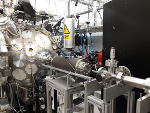Nuclear diagnostics and MRI: 3rd and 4th year option course
Outline
Module outline presented at May 2020 options fair
Module overview prepared as introductory handout
Overview
The course will run in the spring term from 15th February to 26th March 2021 and will be presented "online" in a mixture of asynchronous, pre-recorded "blocks" and synchronous "question and application" sessions.
The more "theoretical" content be delivered in the form of topic-specific mini lectures augmented by "active learning" online, e.g. "quizzes", mini literature-review projects, and problems. This material will be prepared by the lecturer (Ken Long) and course associate (Ruth McLauchlan) and released weekly by the Physics Undergraduate Office.
The synchronous content will address the practical application of the nuclear medicine and MRI techniques in the clinic. This material will be presented by practising medical physicists experts in the various field. Contributions will be made by Kuldip Nijran and Rebecca Quest from the Imperial College Healthcare NHS Trust and Sonia Nielles Vallespin from the National Heart and Lung Institute.
The synchronous content will be delivered in "Question and application" (Q&A) sessions. There will be two of these sessions each week; the first on Wednesdays at 11:00 and the second on Fridays at 14:00. Each Q&A session will include protected time allocated for the students to raise questions related to any of the material presented in the course.
Two problem sheets will be issued during the course, the first in week 3, the second in week 7.
Assessment will be 100% by exam. The exam will be based on the asynchronous taught content and the material presented in the Q&A sessions.
Asynchonous content
Exam -- "Timed remote assessment"
Guidance provided by the Physics UG office
Attachments (62)
- PhysicsMedicalImagingNuclearDiagnosticsandMRI2020-21.pdf (178.1 KB ) - added by 5 years ago.
- NDnMRI-overview.pdf (65.4 KB ) - added by 5 years ago.
- ESOGE.2020.55-TRA-Guide.pdf (163.6 KB ) - added by 5 years ago.
- Wk01-Lctr03-Sctn05.pdf (928.4 KB ) - added by 5 years ago.
- Wk01-Lctr03-Sctn04.pdf (637.1 KB ) - added by 5 years ago.
- Wk01-Lctr03-Sctn01.pdf (3.1 MB ) - added by 5 years ago.
- NM_Q&A sessions.docx (15.2 KB ) - added by 5 years ago.
- 2021_ACTIVE LEARNING SUGGESTIONS.docx (15.6 KB ) - added by 5 years ago.
- 2021_ACTIVE-LEARNING-SUGGESTIONS.docx (15.6 KB ) - added by 5 years ago.
- NM_Q&A-sessions.docx (15.2 KB ) - added by 5 years ago.
- Wk01-Lctr01-Sctn01.pdf (684.2 KB ) - added by 5 years ago.
- Wk01-Lctr01-Sctn02.pdf (3.3 MB ) - added by 5 years ago.
- Wk01-Lctr02-Sctn01.pdf (730.4 KB ) - added by 5 years ago.
- Wk01-Lctr02-Sctn02.pdf (1.1 MB ) - added by 5 years ago.
- Wk01-Lctr02.pdf (1.6 MB ) - added by 5 years ago.
- Wk01-Lctr01-Sctn03.pdf (962.5 KB ) - added by 5 years ago.
- Wk01-Lctr01.pdf (4.3 MB ) - added by 5 years ago.
- Wk01-Lctr03-Sctn02.pdf (993.0 KB ) - added by 5 years ago.
- Wk01-Lctr03-Sctn03.pdf (1.3 MB ) - added by 5 years ago.
- Wk01-Lctr03.pdf (5.6 MB ) - added by 5 years ago.
- Wk02-Lctr04.pdf (4.6 MB ) - added by 5 years ago.
- Wk02-Lctr04-Sctn05.pdf (461.7 KB ) - added by 5 years ago.
- Wk02-Lctr04-Sctn03.pdf (622.0 KB ) - added by 5 years ago.
- Wk02-Lctr04-Sctn04.pdf (403.5 KB ) - added by 5 years ago.
- Wk02-Lctr04-Sctn02.pdf (2.7 MB ) - added by 5 years ago.
- Wk02-Lctr04-Sctn01.pdf (1.7 MB ) - added by 5 years ago.
- Wk02-Lctr05.pdf (2.5 MB ) - added by 5 years ago.
- Wk02-Lctr05-Sctn03.pdf (395.0 KB ) - added by 5 years ago.
- Wk02-Lctr05-Sctn02.pdf (1.1 MB ) - added by 5 years ago.
- Wk02-Lctr05-Sctn01.pdf (1.7 MB ) - added by 5 years ago.
- Wk03-Lctr06.pdf (1.6 MB ) - added by 5 years ago.
- Wk03-Lctr06-Sctn04.pdf (427.6 KB ) - added by 5 years ago.
- Wk03-Lctr06-Sctn05.pdf (730.0 KB ) - added by 5 years ago.
- Wk03-Lctr06-Sctn03.pdf (545.1 KB ) - added by 5 years ago.
- Wk03-Lctr06-Sctn02.pdf (686.5 KB ) - added by 5 years ago.
- Wk03-Lctr06-Sctn01.pdf (524.3 KB ) - added by 5 years ago.
- Wk03-Lctr07.pdf (7.2 MB ) - added by 5 years ago.
- Wk03-Lctr07-Sctn02.pdf (648.9 KB ) - added by 5 years ago.
- Wk03-Lctr07-Sctn01.pdf (6.9 MB ) - added by 5 years ago.
- Wk04-Lctr08-Sctn01.pdf (690.5 KB ) - added by 5 years ago.
- Wk04-Lctr08-Sctn02.pdf (4.4 MB ) - added by 5 years ago.
- Wk04-Lctr08-Sctn03.pdf (933.7 KB ) - added by 5 years ago.
- Wk04-Lctr08.pdf (5.4 MB ) - added by 5 years ago.
- Wk04-Lctr09.pdf (14.5 MB ) - added by 5 years ago.
- Wk04-Lctr09-Sctn01.pdf (4.0 MB ) - added by 5 years ago.
- Wk04-Lctr09-Sctn02.pdf (10.8 MB ) - added by 5 years ago.
- Wk05-Lctr10-Sctn01.pdf (1.1 MB ) - added by 5 years ago.
- Wk05-Lctr10-Sctn02.pdf (4.4 MB ) - added by 5 years ago.
- Wk05-Lctr10-Sctn03.pdf (751.4 KB ) - added by 5 years ago.
- Wk05-Lctr10.pdf (5.5 MB ) - added by 5 years ago.
- Wk05-Lctr11-Sctn01.pdf (574.8 KB ) - added by 5 years ago.
- Wk05-Lctr11-Sctn02.pdf (512.6 KB ) - added by 5 years ago.
- Wk05-Lctr11-Sctn03.pdf (836.6 KB ) - added by 5 years ago.
- Wk05-Lctr11-Sctn04.pdf (2.0 MB ) - added by 5 years ago.
- Wk05-Lctr11.pdf (2.9 MB ) - added by 5 years ago.
- Wk06-Lctr12-Sctn01.pdf (1.9 MB ) - added by 5 years ago.
- Wk06-Lctr12-Sctn02.pdf (1.2 MB ) - added by 5 years ago.
- Wk06-Lctr12-Sctn03.pdf (807.6 KB ) - added by 5 years ago.
- Wk06-Lctr12.pdf (3.2 MB ) - added by 5 years ago.
- Wk06-Lctr13-Sctn01.pdf (2.7 MB ) - added by 5 years ago.
- Wk06-Lctr13-Sctn02.pdf (1.7 MB ) - added by 5 years ago.
- Wk06-Lctr13.pdf (4.1 MB ) - added by 5 years ago.
Download all attachments as: .zip
